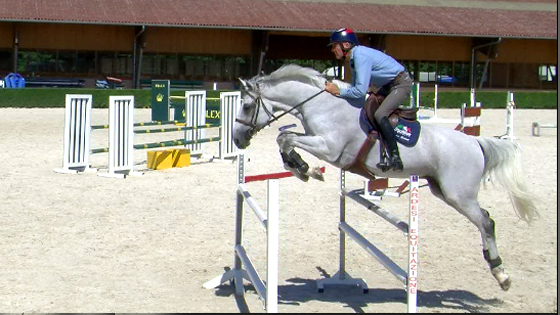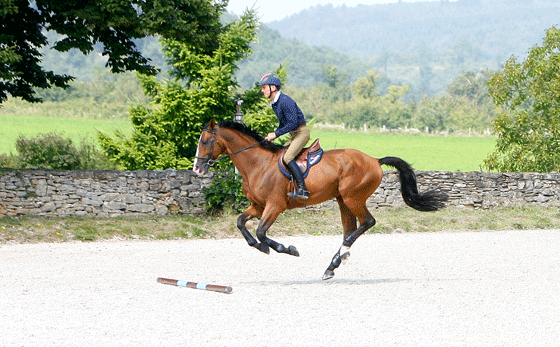Regularity of the canter while approaching fences . part 5
The goal is to improve the regularity of the canter while approaching fences. Michel begins with a rider’s position check-up. The session continues with some in-depth flat work, especially to obtain more responsiveness from Pierre’s horse.
5 videos - Total time: 53 mn
Pierre would like to work on the regularity and quality of his horse’s canter as he approaches fences.
First part: Flat work
Michel begins with a rider’s position check-up to improve the rider’s ability to follow his horse movements. Pierre has to unblock his legs and keep his hands steady in order to reach a constant contact.
He also has to pay attention to his path. For that, Michel asks him to perform a circle in an imaginary corridor. The simple fact of having a precise path enables Pierre to get a better connection with Quatmandou.
Pierre will then look to get his horse on the bit. The goal is the reach a position that would be less closed in, less forced up. For that, Michel encourages him to test his feelings and his horse reactions in the opposite position….i.e. very open. By working in the 2 extreme positions, Pierre and his horse will find a comfortable in-between position.
The training on the flat work continues with some transitions at different gaits, still staying on a precise path. This work goes toward the goal of this session which is to be able to accelerate or slow down while keeping a responsive horse.
The canter work is done on a large oval shape allowing Pierre to work on a succession of straight lines and turns to simulate the conditions of a course. All this work has to be done still observing a precise cadence.
Second part: jumping
The training continues with some ground poles along the 2 diagonal-lines of the indoor arena. In the approach of each pole, Pierre has to imagine he’s coming toward a huge fence. In order to not impair his body movements, Pierre has to keep breathing, especially while approaching fences.
Then, Michel sets-up a vertical on one of the diagonals. Very fast, he realises that Quatmanda has a tendency to lose his pushing power, particularly when the take-off stride is not at the ideal spot. So, Michel arranges a set-up that will solve this issue.
Pierre has a tendency to assist his horse by preventing him to do the fault. On the contrary he has to make his horse aware of his responsibilities by letting him find the solution to jump correctly. It implies that the rider
The session moves on with some lines and combinations of fences. Pierre has to memorise the feeling of a good quality canter on the ground poles and has to try to maintain it at all time on the course.


